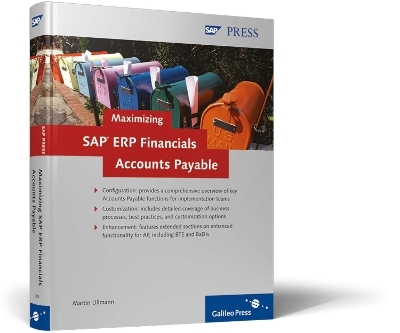
Maximizing SAP ERP Financials Accounts Payable
SAP Press (Verlag)
978-1-59229-198-4 (ISBN)
- Titel ist leider vergriffen;
keine Neuauflage - Artikel merken
Martin Ullman is an SAP Integration/Project Manager with 13 years of experience working on implementations and upgrades. His specialty is the FI module, including Accounts Payable, General Ledger, and the Public Sector vertical. He has been presenting on FI-related topics at the SAP Financials Conference since 2004, and has been writing for Financials Expert newsletter since 2003.
Acknowledgments 15
1 Overview 17
1.1 Introduction 17
1.2 Brief history of SAP 20
1.3 SAP Implementation Overview 21
1.4 SAP Navigation Basics 25
1.5 Summary 31
2 SAP Enterprise Structure 33
2.1 Building an Enterprise Structure 34
2.2 Building a Straw Man 35
2.3 Straw Man Design 39
2.4 Configuration of Enterprise Structure 41
2.5 Summary 65
3 Financial Accounting Component (FI) Global Settings 67
3.1 What Is a Document in SAP? 68
3.2 Configuration of Global Settings 71
3.3 Sales and Purchase Tax 109
3.4 Summary 119
4 New General Ledger 121
4.1 Overview of the GL 122
4.2 Building Your New GL Blueprint 127
4.3 Configuration Steps to Activate the New GL 129
4.4 Summary 162
5 Accounts Payable 163
5.1 Overview of the P2P cycle 164
5.2 Building an AP Business Model 167
5.3 Master Data 168
5.4 Vendor Account Groups 171
5.5 Vendor Number Ranges 180
5.6 Accounting Clerks 185
5.7 Define Sensitive Fields for Dual Control 186
5.8 House Banks 188
5.9 Invoice Processing 193
5.10 Document Parking 197
5.11 Outgoing Payments Processing 198
5.12 Summary 213
6 Accounts Receivable 215
6.1 Overview of the Order-to-Cash Process 215
6.2 Building an Accounts Receivable Business Model 218
6.3 Master Data 219
6.4 Customer Master Records 219
6.5 Finance Documents Global Settings 236
6.6 Customer Invoice Processing 237
6.7 Customer Payments 239
6.8 Debtor Management 246
6.9 Summary 264
7 Asset Accounting 265
7.1 Overview of Asset Accounting 266
7.2 Building Blocks of Asset Accounting 267
7.3 Building an Asset Accounting Business Model 272
7.4 Asset Accounting Configuration 273
7.5 Asset transaction processing 304
7.6 Summary 320
8 Controlling Component (CO) in SAP ERP 323
8.1 Overview and Diagram 324
8.2 Subcomponents of the Controlling Component (CO) 325
8.3 Building a Controlling Model 327
8.4 Configuration Settings in the Controlling Component (CO) 330
8.5 Summary 361
9 ERP Financials Integration 363
9.1 Automatic Account Determination 365
9.2 Master Data 382
9.3 Interfaces 390
9.4 The Value of Integration Testing 396
9.5 Summary 396
10 Data Migration 397
10.1 Key Principles of Data Migration 398
10.2 The Six-Step Migration Model 399
10.3 Inventory Transfer 404
10.4 Open Items Transfer 405
10.5 Upgrade to SAP ERP ECC 6.0 406
10.6 Asset Accounting Legacy Data Transfer 407
10.7 Summary 413
11 Period-End Closing 415
11.1 Fast Close with the New GL 416
11.2 Key Elements of a Period End Timetable 417
11.3 Dependent Activities Already Completed 417
11.4 Analysis of Period-End Activities 417
11.5 Summary 424
12 SAP ERP Financials Reporting 425
12.1 Building Your Reporting Suite 425
12.2 Reporting Tools 427
12.3 Common Reporting Requirements 429
12.4 Creating Basic Management Accounting Reports with Report Painter 435
12.5 Summary 455
| Erscheint lt. Verlag | 25.11.2008 |
|---|---|
| Verlagsort | Maryland |
| Sprache | englisch |
| Einbandart | gebunden |
| Themenwelt | Mathematik / Informatik ► Informatik ► Netzwerke |
| Informatik ► Weitere Themen ► SAP | |
| ISBN-10 | 1-59229-198-8 / 1592291988 |
| ISBN-13 | 978-1-59229-198-4 / 9781592291984 |
| Zustand | Neuware |
| Informationen gemäß Produktsicherheitsverordnung (GPSR) | |
| Haben Sie eine Frage zum Produkt? |
aus dem Bereich


